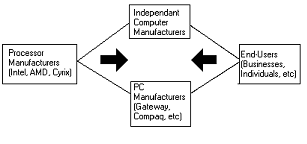The purpose of conducting an industry analysis is to understand what kind environment a company works in and how various players in the market interact with each other. A company’s profitability and continued survival is based, to a great degree, on how powerful a role it plays in the industry and whether it has some influence over the market or not.
AMD’s industry structure is explained in the following diagram:

End-users have the most influence and power in this industry. They decide which chip they want in their computers, and this influences whom the computer manufacturer does business with. This in turn increases the clout of that specific chip. The chipmakers, in turn, use this power to influence computer manufacturers.
A good example of the power that processor manufacturers have computer makers is shown by Intel relationship with the computer makers that use Intel chips. The story behind why most computers have the “Intel Inside” logo on them is that Intel was once the most dominant maker of high-end processors in the world. Since most people wanted Intel chips, Intel decided to flex its corporate muscles and forced computer manufacturers to comply with certain conditions or risk losing their supply of Intel chips. Most manufacturers complied; one of the rules was that computers using Intel chips had to have the “Intel Inside” sticker on them. Computer manufacturers are dead scared of upsetting their suppliers.
As it must be apparent by now, the great white shark in the processor industry is Intel. It controls a large portion of the market. As a norm, companies like AMD and Cyrix are forced to settle for small contracts with computer makers. Although AMD has some power over computer makers, it cannot utilize it completely in the fear of driving its current buyers to other manufacturers or even Intel. Intel’s existence and continued dominance over the processor industry keeps the other manufacturers in check.
